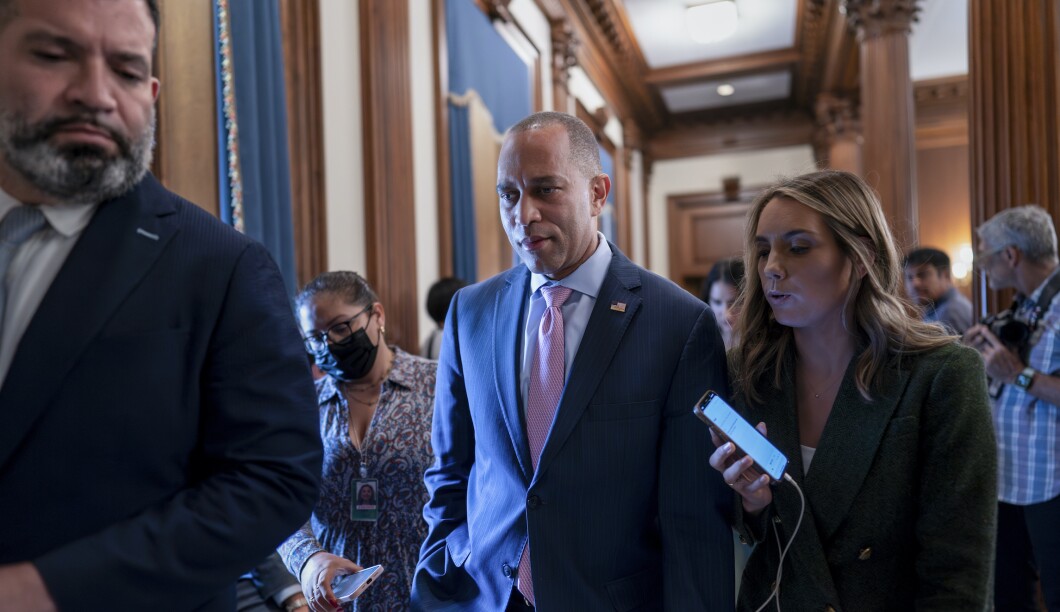
The ouster of Rep. Kevin McCarthy (R-CA) as speaker has inflamed partisan tensions in the House at a time when bipartisanship will be necessary to keep the government open.
A deal to extend funding for 45 days gave lawmakers more time to broker a compromise on spending levels for the remainder of the year. But it also became the catalyst for an intraparty rebellion McCarthy faced for working with Democrats.
THE RACE IS ON: WHO COULD REPLACE MCCARTHY AS SPEAKER?
Just eight Republicans voted to oust McCarthy on Tuesday, plunging the GOP into turmoil and leading to bitter denunciations of Rep. Matt Gaetz (R-FL), the conservative ringleader who called for a no-confidence vote.
But equally fierce was the Republican outrage against Democrats, who stood united in voting McCarthy out of the speakership. In one of his first acts as interim speaker, Rep. Patrick McHenry (R-NC) booted Speaker Emeritus Nancy Pelosi (D-CA) and her ex-deputy Steny Hoyer (D-MD) from their ancillary offices at the Capitol, a move viewed as revenge for the vote.
Republicans argued the offices belong to the preceding speaker, meaning McCarthy, but Democrats dismissed the decision as “mean and petty.”
Even normally cooperative caucuses have descended into partisanship, as Republicans in the Problem Solvers Caucus openly mull a split with their Democratic colleagues.
“This was supposed to be a time when Problem Solvers were supposed to drop their partisanship and do what’s right for America,” Rep. Nick LaLota (R-NY) told the Wall Street Journal. “I’m tremendously disappointed that nobody — no Democrat Problem Solver — stepped up to do so, and I’m reassessing if I’ll remain a member of that caucus.”
The outcome was not altogether a surprise. Democrats, distrustful of McCarthy over his decision to pursue spending levels below the debt ceiling compromise he negotiated with President Joe Biden, saw little distinction between him and the hard-liners he’s catered to the last nine months. His decision to open an impeachment inquiry into the president in September poisoned the well further.
Yet Republicans were holding out hope that centrist members would extend McCarthy a lifeline for the “sake of the institution.”
No such lifeline materialized on Tuesday as every coalition in the Democratic caucus lined up behind Minority Leader Hakeem Jeffries (D-NY) in supporting McCarthy’s ouster, a vote they framed as a stand against dysfunction and extremism in Washington.

In the aftermath, Democratic leadership has emphasized bipartisan cooperation. Jeffries urged “traditional Republicans” to “walk away from MAGA extremism and join us in partnership.” Biden called on both parties to “stop seeing each other as enemies.”
“We cannot and should not again be faced with the eleventh-hour decision of brinkmanship which threatens to shut down the government,” he said on Wednesday.
Yet Republicans reduce Democrats’ Tuesday vote to nothing more than a political calculation. The party has made Republican infighting central to its appeal to suburban voters exhausted by gridlock and near-economic calamity.
Democrats may not like who replaces McCarthy, with the leading contenders, Majority Leader Steve Scalise (R-LA) and Judiciary Committee Chairman Jim Jordan (R-OH), thought to be more conservative and less willing to compromise. Yet McCarthy served as a fundraising powerhouse for House Republicans, and the spectacle of another protracted speaker’s race furthers Democratic messaging.
Jeffries, who had maintained a collegial relationship with McCarthy, sent a fundraising email on Wednesday highlighting the “chaos, crisis and confusion” in the House.
His removal has more immediate implications. McHenry serves in a largely ceremonial role, and it’s thought he cannot do much more than gavel the chamber in and out of session.
That leaves government funding, which will expire on Nov. 17, in total limbo. House Republicans had planned to take up two appropriations bills this week, votes that were scrapped after the revolt. Until a new speaker is installed — unlikely to be a smooth process given the 15 rounds it took McCarthy to win — the push for government funding will remain at a standstill.
Ironically, the same stopgap that averted a government shutdown with just hours to spare on Saturday will lead to days, and perhaps weeks, of squandered floor time.
Republicans could, of course, eventually pass another Band-Aid that extends funding into December, but the very idea of a continuing resolution, as the measure is known, is anathema to hard-liners, who believe leadership all along has wanted a last-minute omnibus that lacks input from rank-and-file members.
Even incredibly conservative bills to fund the government have faced insurmountable resistance, meaning any funding legislation, whether a stopgap or yearlong appropriation, will require the votes of Democrats, who control the Senate and White House.
The bitterness following McCarthy’s ouster only makes that cooperation more difficult.
The upper chamber has hardly been more productive. It spent no time considering its first appropriation bills this week, leading 12 Republicans to send Majority Leader Chuck Schumer (D-NY) a Wednesday letter demanding the Senate stay in session every weekday until all spending bills are passed.
CLICK HERE TO READ MORE FROM THE WASHINGTON EXAMINER
“While valuable work is done while Senators are back in their home states, it is imperative that we remain in DC until our appropriations work can be completed,” the letter, signed by members including Minority Whip John Thune (R-SD), said. “That is what the American people expect and deserve of us.”
Senators such as Markwayne Mullin (R-OK), an ally of McCarthy who until last year served in the House, are already predicting another continuing resolution will be needed.





